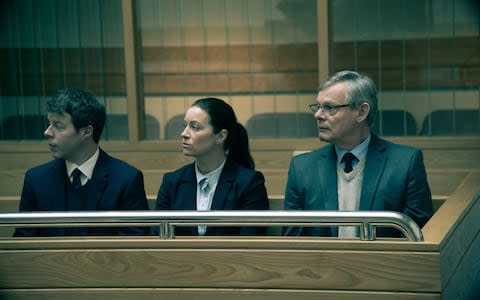Manhunt, episode 3 review: a respectful act of bearing witness to a terrible evil

There will never be closure for the victims of serial killer Levi Bellfield, or for their families, so it would be outrageous to claim that Manhunt, ITV’s chronicling of Bellfield’s capture and eventual conviction, had a happy ending. But it was nonetheless satisfying to see mild-mannered Met detective Colin Sutton (Martin Clunes) have his big TV cop moment as he locked gazes with Bellfield and charged the misogynistic sociopath with the murder of two young women.
Amélie Delagrange and Marsha McDonnell were real people, of course, as was 13-year-old Milly Dowler, whose killing Bellfield was also subsequently found guilty of. The obvious concern was thus that Ed Whitmore’s adaptation of Sutton’s memoirs might slip into grisly exploitation.
Manhunt, in fact, functioned as a respectful act of bearing witness. It certainly didn’t romanticise the shoe-leather police work that lead to Bellfield’s arrest in the three-part series’s concluding episode. A raid on the suspect’s home was initially frustrating for the police, before they found Bellfield (Celyn Jones) hidden in the attic. Just as plodding was the search for the all-important shopping receipt that backed up Bellfield's partner Laura Marsh’s account of his movements on the night of Delagrange's death. This finally convinced the Crown Prosecution Service to bring charges.

As the introspective Detective Chief Inspector Sutton, Clunes smartly kept his emotions beneath the surface. Therefore it was all the more shocking when he blew his top, as he did when Surrey police fobbed off his theory that Bellfield was responsible for the death of Milly Dowler in 2002. As Bellfield, Jones was both skin-crawling and pathetic. He established the killer’s sociopathy without elevating him.
Eventually prised from his attic, Bellfield was portrayed as a study in slimy machismo, within which slithered a serpentine cunning. He knew the police couldn’t connect him to the Ford van caught on CCTV near Twickenham Common, where Delagrange was killed. So he just sat and leered at DS Jo Brunt (Katie Lyon), confident he held all the cards.
His downfall was the testimony of his abused partner Laura Marsh (a fictional name used for this drama). She had suffered physical and sexual abuse at his hands – enough for the police to lock him away while trying to firm up their murder inquiry. After that, it was a case of agonisingly connecting the dots so that Bellfield could be definitively tied to Delagrange’s death.

The warts-and-all picture of police work as glorified data collection was augmented by insights into the rivalries of what were essentially competing investigations. The Surrey detectives on the trail of Milly Dowler’s killer already had a suspect and didn’t thank Sutton for his bombshell that they’d been looking in the wrong place all this time. The role human error can play was also highlighted with police mishandling of video footage of a hit and run assault by Bellfield identified as crucial in allowing him to stay on the streets, free to kill Delagrange.
The domestic toll the obsession took on Sutton’s relationship with his police statistician wife (Claudie Blakley) was touched on too, though never melodramatically. And Manhunt finished on an appropriately sober note with the images of Bellfield’s victims appearing on screen before the final credits. For anyone who had enjoyed the thrill of the chase it was a reminder that this was no game of cat and mouse, but the grisly aftermath of a terrible evil visited upon real people.

